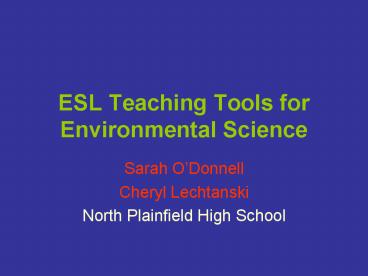ESL Teaching Tools for Environmental Science - PowerPoint PPT Presentation
1 / 19
Title:
ESL Teaching Tools for Environmental Science
Description:
Crossword Puzzles. Water Pollution. Games. Food Chain Game (based on Loch Ness) ... Crossword Puzzles. Water Pollution Crossword Puzzle (http://www.puzzlemaker. ... – PowerPoint PPT presentation
Number of Views:1058
Avg rating:3.0/5.0
Title: ESL Teaching Tools for Environmental Science
1
ESL Teaching Tools for Environmental Science
- Sarah ODonnell
- Cheryl Lechtanski
- North Plainfield High School
2
Objectives
- Share a number of teaching tools
- Currently in use at North Plainfield High School
- Aligns with the Sheltered Instruction Observation
Protocol (SIOP) model
3
Our Application of the SIOP Model
- Content (science) and language objectives
- Building background
- Scaffolding
- Verbal, e.g., questioning
- Procedural, e.g., partnering
- Instructional, e.g., graphic organizers
- Variety of activities
4
Current Applications
- Environmental Science course
- Sheltered
- Non-sheltered
5
Webquests
- Virtual Tours ( http//www.efieldtrips.org )
- Examples
6
Field Trips
- Raptor Trust (Millington, NJ)
- http//www.theraptortrust.org
7
Games
- Food Chain Game
- Crossword Puzzles
- Water Pollution
8
Games
- Food Chain Game (based on Loch Ness)
- http//www.3dlochness.com/schools-info.htm
9
Games
- Crossword Puzzles
- Water Pollution Crossword Puzzle
- (http//www.puzzlemaker.com )
10
Activities
- White Deer Population
- Think, Pair, Share
- Food Chains and Trophic Levels
- Draw an Atom
11
Activities
- White Deer Population
- Adapted from Penn State Environment and
Ecological Lesson Plan Series, where students - Calculate deer population growth on a deer farm
where harvesting occurs - Analyze data and suggest good management
practices
12
Activities
- Think, Pair, Share
- Build an animal
- Assessment on understanding of adaptation, where
students - Select a biome
- Create a fictitious animal with adaptations that
allow it to survive in the chosen biome - List the specific adaptations and their survival
benefits - Present work to class
13
Activities
- Food Chains and Trophic Levels, where students
- Learn new vocabulary
- Identify a list of organisms as producers,
consumers, or decomposers
14
Activities
- Draw an Atom
- Assessment on the components of an atom
- Each student draws an atom from the Periodic
Table
15
Labs
- Mark and Recapture Lab
- Dew Point Lab
- What is a Greenhouse? Lab
- pH Lab Do we have acid rain?
16
Labs
- Mark and Recapture Lab, where students
- Learn concepts and vocabulary of population size
estimation - Apply mark and recapture procedure using peanuts,
paper bags and markers - Evaluate pros and cons of procedure
17
Labs
- Dew Point Lab, where students
- Learn concept and vocabulary of dew point
- Measure dew point using the cold can method
- Write a summary of what they learned
18
Labs
- What is a Greenhouse? Lab
- EPA Report No. EPA/600/R-93/126. U.S.
Environmental Protection Agency - http//www.ucar.edu/learn/1_3_2_12t.htm
19
Labs
- pH Lab Do we have acid rain in North
Plainfield?, where students - Learn and apply pH scale
- Compare pH of tap water, rain water, cola,
vinegar and soapy water

